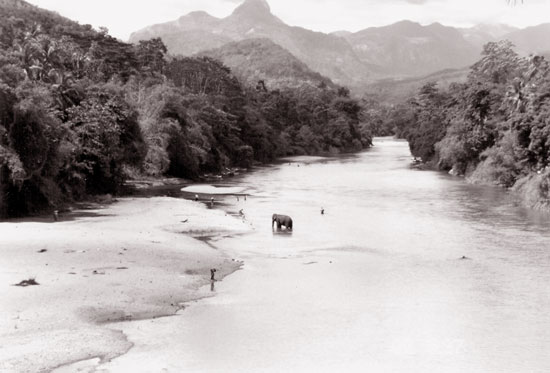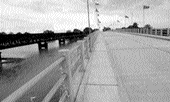Across the ferry at "Kattoogastotte"
When a Governor danced on a bridge
By Padma Edirisinghe
The newly built Katugastota bridge was opened for traffic during the
governorship of Henry Ward at the Northern End of the picturesque hill
city of Mahanuwara. Today it is back in the news in the context of the
envisaged re-construction project by the President.
About 150 years ago in 1856 after its construction there had been
great rejoicing in the hill capital followed by a sumptuous dinner and a
dance in which the governor himself participated.
A census of traffic taken in 1904 reads as follows
1 carriage & pair
18 single horse carriages
4 two-wheeled horse carriages
1 horse
12 rickshaws
5 bicycles
9 Hackery buggies
1 Hackery
48 double bullock carts (loaded) & 30 double bullock carts (unloaded
10 single bullock carts (loaded) & 6 single bullock carts (unloaded)
34 oxen
1 buffalo
6525 Pedestrians
One can visualize the bullock carts, the hackeries, the rickshaws
trail languidly along the original bridge open to traffic in 1856 in
Governor Ward's time. Said to be an occasion of great rejoicing.
Governor Henry Ward's minute reads,
"I had the pleasure of opening the Kattogasttota bridge in the
presence of the largest concourse of Europeans and natives, that was
ever brought together in the Central Province .... The undertaking is
one that no changes in the internal communications of the Island can
affect, short of the entire trade of Trincomalee and even the
communication between Kandy and Matale.....when Colombo is the port of
shipment for the whole of Central Province."
|

Where nature herself has made provision for the erection of
a bridge |
This bridge, one of the most famous in the Island, substituted the
ferry service which even at its optimum regulated running had caused
much delays and losses for planters of the Central highlands.
After the opening ceremony it is said that 250 guests sat down to a 'Dejenear
Diaatoire' followed by a dance on the bridge in which H. E, Governor
Henry Ward too took part.

The Kandy-Matale road itself was opened in 1831, which feat commenced
the gradual abolition of compulsory labour in Ceylon. This is notified
in acircular dated 12th November 1851 signed by P. Anthruther, Deputy
Secretary to Government.
'You will not hereafter consider yourself at liberty to exact the
gratuitous labour of any person'.
The Governorship of Sir Henry Ward (1855 - 1860) saw great progress
in the development of the Island's communications.
The opening of the electric telegraph to Kandy and Mannar and
deposition of the cable between Ceylon and India at the Pamban Straits
were other achievements. With remarkable foresight Ward observed the
immense significance of the site of the Ferry service at 'Katugasttotta'
as regards the economy and communications of the country and hastened
the construction of the bridge.
In his submission of urgency of this plan, he writes, 'At
Katugastotta, a little above the present ferry nature itself has made
provision for the erection of a bridge by a reef of rocks presenting
every facility for the piers and an abundant supply of stone for the
abutments.
It is proposed to construct here an iron lattice bridge, 420 feet in
span ....' a more useful and comprehensive scheme has seldom been
submitted to a Colonial Legislature.
Foremost among the backstage workers of this massive iron and steel
structure that yet spans the Mahaweli like a shining black giant, is the
great Engineer, Major Thomas Skinner. Another was Caley, who is
responsible for the curious emblem on the tablet placed in 1856 when the
bridge was opened for traffic, which reads Sir H. G. Ward, GCMG.
Governor, this work was begun 1st September, 1858 and opened to traffic,
1st March, 1860.
The monogram, beneath this reading is said to be similar to the
national emblem of the isle of Man, a sign of Pre-Roman Celtic origin.
Caley, an engineer who worked on the bridge was the youngest son of a
member of an old family who had lived in the isle of Man for many
generations and Caley inserted his national emblem in the tablet of the
'Katugastotte bridge'. Of much mention in this feat is also a local
person, Moothiya Pillai Wellopillay, Mudaliyar, a scion of an old Tamil
family claiming royal descent, and a handsome six-footer.
On completion of the bridge he was made a Mudaliyar of the Governor's
Gate and presented a Gold Medal.
He is said to have died on his horse, enroute to Jaffna.
The two other tablets alongside the bridge carry 5 names of these
Engineers and pioneers who built such a massive structure in a matter of
two years in a background of paucity of plant and qualified labour. The
5 are Major Thomas Skinner (Commissioner of Public Works), J. A. Caley,
W. Lappen, J. Robertson and M. Wellopulley (Division Pioneer.)
The bridge has been reconstructed and repaired from time to time
since 1856, the year in which our longest river Mahaweli started rolling
down under this amazing complicated structure of iron and steel that
rovolutionized the communication arena of the North of Mahanuwara in the
19th Century that had hitherto depended on the slow and languid Ferry
Service at a 'Thota' (crossing) surrounded by thorny trees (Katugas),
hence 'Katugasthota'. |
